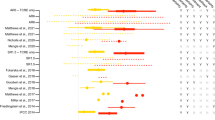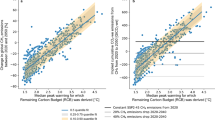Abstract
With the adoption of the Berlin Mandate, developed countries are being asked to set emission limits for the early decades of the next century. The size of the reductions is currently the subject of international negotiations. This paper is intended to contribute to the analysis and assessment phase leading up to the adoption of new targets and timetables. However, we take a somewhat different approach than that suggested by the Berlin Mandate. Rather than focus exclusively on the next steps by developed countries, we view the issue from the perspective of the Convention's ultimate objective, the stabilization of atmospheric concentrations. We examine what might constitute cost‐effective strategies for limiting CO2 concentrations to alternative levels. We then explore the implications for near‐term mitigation decisions and for long‐term participation by the developing countries.
Similar content being viewed by others
References
R. Coase, The problem of social cost, Journal of Law and Economics 3 (1960).
Energy Modeling Forum, Reducing global carbon emissions: Costs and policy options, EMF-12, Stanford University, Stanford, CA (1993).
Intergovernmental Negotiating Committee for a Framework Convention on Climate Change, 5th session, 2nd part, New York, 30 April–9 May, 1992.
IPCC, Climate Change 1992 (Cambridge University Press, Cambridge, 1992).
IPCC, Climate Change 1994 (Cambridge University Press, Cambridge, 1994).
IPCC, Climate Change 1995 (Cambridge University Press, Cambridge, 1996).
R. Kosobud, T. Daly, D. South and K. Quinn, Tradable cumulative CO2 permits and global warming control, The Energy Journal 15(2) (1994).
A. Manne, R. Mendelsohn and R. Richels, MERGE: A model for evaluating regional and global effects of GHG reduction policies, Energy Policy 23(1) (1995).
A. Manne and R. Richels, The greenhouse debate: Economic efficiency, burden sharing and hedging strategies, The Energy Journal 16(4) (1995).
A. Manne and R. Richels, The Berlin Mandate: The cost of meeting post-2000 targets and timetables, Energy Policy 24(3) (1996).
A. Manne and L. Schrattenholzer, International Energy Workshop, International Institute for Applied Systems Analysis, Laxenburg, Austria (January 1996).
W. Nordhaus, The Efficient Use of Energy Resources (Yale University Press, New Haven, 1979).
R. Richels and J. Edmonds, The economics of stabilizing atmospheric CO2 concentrations, Energy Policy 23(4/5) (1995).
R. Richels, J. Edmonds, H. Gruenspecht and T. Wigley, The Berlin Mandate: The design of cost effective mitigation strategies, EMF-14, Working Paper 3, Stanford University, Stanford, CA (1996).
United Nations Climate Change Bulletin 7(2) (1995).
T. Wigley, R. Richels and J. Edmonds, Economic and environmental choices in the stabilization of atmospheric CO2 concentrations, Nature 379 (1996).
Author information
Authors and Affiliations
Rights and permissions
About this article
Cite this article
Manne, A., Richels, R. On stabilizing CO2 concentrations – cost‐effective emission reduction strategies. Environmental Modeling & Assessment 2, 251–265 (1997). https://doi.org/10.1023/A:1019038100805
Issue Date:
DOI: https://doi.org/10.1023/A:1019038100805




